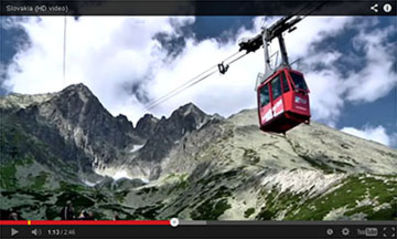In Slovakia there are still unknown and undiscovered places that are exceptional for their beautiful nature, rich cultural heritage, and kind and hospitable people. KROMPACHY and its surroundings is one such place.
Despite the rich mining and metallurgy tradition, the town of KROMPACHY is known, both in Slovakia and abroad, especially for its Plejsy Ski Resort. Nevertheless, the magnificent scenery of hills, valleys, forests and meadows, as well as the precious cultural and historical sights, allow Krompachy to provide optimum conditions for recreation also in summer months.
HISTORY
The oldest written record related to the town dates back to 1256.
Historical documents prove that Krompachy was an important settlement
and a significant mining and metallurgy centre already in 1282, and
remained so until the end of the 20th century. In the 19th century, a
joint-stock company called Krompašské železiarske ťažiarstvo
was gradually established from small local iron mills. Later on, iron
and copper plate rolling mills were built. The company became the
biggest ironworks in the former Hungarian Empire at the turn of the 20th
century, it was closed after WWI, however. In 1921, the bloody event
known as the Mutiny of Krompachy occurred.
Even as late as the first half of the 20th century, woollen rugs were
woven and fur products were made in Krompachy for folk costumes of broad
surroundings. Not only hollow kitchenware, but also purely decorative
products (figures) were manufactured in potter’s workshop established at
the half of the 20th century. After WWII, Krompachy became a prosperous
town due to industrial production important for the whole former
Czechoslovakia. Since 1991, it has been known as a tourism centre thanks to its Plejsy Ski Resort.
SIGHTS
There is a non-genuine fusiform building structure in the town. The most significant cultural and historical sights of Krompachy include a manor house, a town hall, churches, and a chapel. The manor house dates back to the second third of the 18th century, and was modified in 1797. The town hall dates back to 1763. The Roman Catholic church from the last third of the 18th century was build in the Baroque and Classicist style. Another church, belonging to the Evangelical Church, is pseudo-Gothic and was built in 1883. The sacral sights also include a chapel built in 1776. The 1921 Mutiny of Krompachy Memorial House with a memorial square is a national cultural sight. A tombstone dedicated to the victims of the mutiny is found at the local cemetery. The railway blast furnace (known as “maša”) dating back to 1831 is also an interesting sight.
TIP FOR A TRIP
There are many attractive tourist and sports locations surrounding the town, such as Slovenský raj (The Slovak Paradise), Dreveník and Skalné mesto, the Kojšovská hoľa hill, the Poráčska dolina valley, the protected natural formation of Červené skaly, or the national nature reserve of Sivá brada, that are definitely worth visiting.
Source: TIC Rožňava




